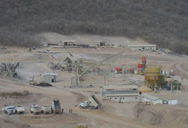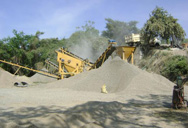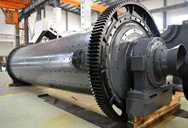for determining cyanide consumption in gold leaching

(PDF) Leaching of gold ores with high cyanicides:
2018.7.10 Optimization of gold leaching and cyanide consumption requires a methodology to estimate the amount of exposed cyanicides,
More
Kinetic Investigation and Dissolution Behavior of Cyanide
2019.5.10 1 Altmetric Metrics Abstract Raising social awareness and environmental specifications on cyanide application force gold industry to search for alternative leaching
More
Review A systematic review of gold extraction: Fundamentals ...
2022.10.15 Over the past three decades, a significant amount of literature has examined alternative lixiviants to cyanide for recovering gold, while few industrial
More
Cyanide consumption analysis in laboratory gold leaching applications ...
2012.12.12 Knowledge of the cyanide consumption in gold leaching is important for process design and optimisation. Laboratory tests are often used for predictions of
More
Leaching and recovery of gold from ore in cyanide-free glycine media ...
2020.11.1 Optimal leaching parameters for gold extraction were evaluated using response surface methodology. The investigated parameter range was 0.5–2 M for
More
Factors influencing the rate of gold cyanide leaching and adsorption
2011.5.1 Conduct bench scale testing to determine the rate of gold leaching (under the previously established optimum conditions) and the rate of gold cyanide adsorption
More
Predicting Cyanide Consumption in Gold Leaching: A
2018.3.8 1. Introduction Gold is mainly extracted from its ores or concentrates by leaching with oxygenated cyanide solutions [1,2]. Cyanide consumption during leaching,
More
Estimating process design gold extraction, leach
2018.10.23 As an illustration, for a gold ore grading 2.3 g/t, a 1% increase in gold recovery generates incremental revenue of about $1/t-ore at a gold price of $1,300/ oz.
More
Lead Oxide Enhances the Leaching of Gold in Cyanide Tailings
2022.12.29 Lead oxide was used to enhance the leaching process of cyanide tailings to improve the leaching efficiency of gold. In the process of conventional cyanide
More
Predicting Cyanide Consumption in Gold Leaching: A Kinetic
2018.3.8 The consumption of cyanide during processing operations is a major economic cost in the extraction of gold from its ores, while the discharge of cyanide wastes may result in significant environmental pollution. Many factors influence the levels of consumption and discharge of cyanide, including ore mineralogy and lixiviant solution
More
(PDF) Leaching of gold ores with high cyanicides:
2018.7.10 Article. The concept of leaching copper–gold ores using leach solutions which contain Cu (CN)32− was investigated. Gold leaching occurs in air saturated Cu (CN)32− solutions at a much slower ...
More
Predicting Cyanide Consumption in Gold Leaching: A Kinetic
In this study, the extraction of gold from a copper-bearing gold ore by ammoniacal cyanide leaching was studied. Furthermore, ammonia leaching as a pretreatment process ahead of cyanide leaching was also examined. Only ~12% of gold was extracted by direct cyanide leaching of the ore. The addition of lead nitrate did not affect the leaching of gold.
More
Review A systematic review of gold extraction: Fundamentals ...
2022.10.15 The presence of glycine leads to low cyanide consumption, high metal recovery, zero or very low free cyanide during leaching, and copper complexed primarily with glycine rather than cyanide in tailing solutions (Oraby et al., 2017). Thus, co-intensifying systems with ammonia or glycine were developed to reduce the adverse effects caused
More
(PDF) Modeling the cyanide consumption in leaching of gold
2017.8.23 Modeling the cyanide consumption in leaching of gold ores based on the amount and liberation degree of cyanicides. August 2017. Conference: 7th International World Gold Conference. At: Vancouver ...
More
Predicting Cyanide Consumption in Gold Leaching: A
2018.3.8 With such a model, consumption of cyanide can be optimized and lowered by manipulating the key factors. While a slurry containing gold, pyrite and chalcopyrite was investigated in this work, the proposed approach can be easily extended and tested with ores or concentrates of quite different mineralogy. 2. Theory.
More
Gold Leaching - 911 Metallurgist
2016.7.12 The following gold leaching test procedure has been found satisfactory for carrying out cyanide leaching tests by agitation. Winchester bottles of about 2.5- to 4-liter capacity are used. It is convenient to number the bottles and determine their tares, etching the figures on the bottle by means of hydrofluoric acid and then marking over the etching
More
Alternative Lixiviants to Cyanide for Leaching Gold Ores
2016.1.1 Higher gold recoveries were achieved with bromine (70%) than with cyanide (23%) when leaching gold encapsulated in sulfides; however, bromine consumption was high (>500 kg/t) owing to simultaneous oxidation of the sulfide minerals. Bromine was also found to be less reactive than cyanide to copper minerals.
More
Leaching and recovery of gold from ore in cyanide-free glycine media ...
2020.11.1 A gold ore sample originated from an epithermal deposit with a composition shown in Table 2 was used as a feed material in the leaching experiments. X-ray fluorescence and inductively coupled plasma optical emission spectrometry (ICP-OES; Thermo Scientific iCAP 6000, USA) were used to determine the chemical composition of
More
Cyanide Destruction in Gold Heap Leach - 911
2017.6.13 The consumption of NaCN is a major expense in heap leach operations that exploit low-grade ore (Barratt and McElroy 1990). ... The most widely accepted procedure for determining total cyanide in
More
Predicting Cyanide Consumption in Gold Leaching: a Kinetic
Recovery of Gold and Iron from Cyanide Tailings with a Combined Direct Reduction Roasting and Leaching Process; Simulation Study of the Optimal Distribution of Cyanide in a Gold Leaching Circuit; Tungsten and Gold Recovery from Alaskan Scheelite-Bearing Ores; Myths and Realities in Artisanal Gold Mining Mercury Contamination; Mercury and ...
More
Estimating process design gold extraction, leach residence
2015.5.1 Cyanide consumption at the Morila Mine Gold Plant had been consistently running at 46 per cent higher than the expected value without any corresponding increase in gold recovery.
More
A Review of Ammoniacal Thiosulfate Leaching of Gold: An
2016.8.2 The factors affecting gold leaching such as pH, temperature, and oxidants in leaching solutions, reagent concentrations, and foreign ions are presented to update the current understanding on gold dissolution in a Cu(II)-NH3-S2O32-system. ... An Update Useful for Further Research in Non-cyanide Gold Lixiviants @article{Zhang2016ARO,
More
(PDF) A systematic review of gold extraction: Fundamentals ...
2022.8.1 Leaching by cyanide has always been dominant in gold extraction since it was develop ed at the end of the 19th century. After more than a century of development, mature industrial
More
How to Process Gold Ores by Heap Leaching Carbon
2021.2.18 The technology for determining whether or not a gold ore is amenable to percolation leaching with weak cyanide solutions is well established. Initially, bottle cyanidation tests are conducted on 200- to 500-gram charges of ground ore to determine the degree of gold extraction and reagent consumption.
More
Gold Leaching – Hydrometallurgy - British Columbia/Yukon
One of the main issues in cyanide leaching for Au is excessive reagent consumption. Many metal ions form very stable cyanide complexes (e.g. [Cu(CN) 3 ] – , [Zn(CN) 4 ] 2- , [Fe(CN) 6 ] 4- , etc.); CN – is fairly easy to oxidize, forming OCN – in some cases; SCN – is readily formed by reactions of some metal sulfides with cyanide.
More
Lime use in gold processing – A review - ScienceDirect
2021.12.1 The gold processing industry is a large consumer of lime reagents in various forms. Its role in gold processing is mainly as a pH control agent for optimal cyanidation leaching of gold, as well as a neutralization agent in refractory gold processing via acidic oxidation routes. There are, however, a range of conditions upstream of
More
Test work to examine the potential for improving gold
2018.7.20 increase in cyanide consumption. The introduction of lead nitrate resulted in a 34 g/t decrease in cyanide consumption. According to La Brooy, Linge, and Walker (1994), reactions involving sulphides may consume cyanide and oxygen and produce various solution species that can decrease the efficiency of gold leaching. Pyrrhotite is
More
Maximising The Value of Gold Diagnostic Leaching PDF Cyanide
2021.6.3 Gold recoveries from cyanide leaching varied significantly across the samples from this gold ore site. and ranged from 9–100%. This indicates a variability in the refractory nature of gold in the deposit. Cyanide leaching at ambient temperature and pressure may therefore not be economically feasible.
More
Simulation study of the optimal distribution of cyanide in a gold ...
2006.11.1 The gold cyanidation leaching process (GCLP) has been the dominant process for the extraction of gold from ores in alkaline cyanide pulp due to its advantages of simple structure, little occupied ...
More
for determining cyanide nsumption in gold leaching
Predicting Cyanide Consumption in Gold Leaching: A Kinetic and Thermodynamic Modeling Approach 1 Introduction Gold is mainly extracted from its ores or concentrates by leaching with oxygenated cyanide solutions [ 2 Theory However, these reactions are simplifications: various copper and iron Computing Cyanide Consumption of a laboratory leach ...
More
Predicting Cyanide Consumption in Gold Leaching: A Kinetic
The consumption of cyanide during processing operations is a major economic cost in the extraction of gold from its ores, while the discharge of cyanide... DOAJ is a unique and extensive index of diverse open access journals from around the world, driven by a growing community, committed to ensuring quality content is freely available online ...
More
(PDF) Kinetic control study of gold leaching with cyanide
2019.9.2 In the cyanide consumption tests, conducted also for the six different size fractions, the pH was maintained at 12, the dissolved oxygen concentration was chosen as 8 mg/L, and the initial free ...
More
Leaching Adsorption Resource Book - 911 Metallurgist
2016.11.2 Many other metals and minerals besides gold also dissolve in alkaline cyanide solution. Some of these metals and minerals have the potential to consume cyanide and oxygen, as well as producing substances which can reduce the efficiency of gold leaching. Minerals that cause excessive consumption of cyanide are called cyanocides.
More
Cyanide concentration in the leach tank - Hydrometallurgy: Leaching
2 天之前 The previous suggestions are relevant. The free cyanide concentration depends of the size of gold grains in the ore. If there is a little bit of sulphides, it may preg-rob gold if the free cyanide is too low. Determine the effect of free cyanide on the leaching profile and retention time at the lab scale.
More
Predicting cyanide consumption in gold leaching: A kinetic
2024.2.7 The consumption of cyanide during processing operations is a major economic cost in the extraction of gold from its ores, while the discharge of cyanide wastes may result in significant environmental pollution. Many factors influence the levels of consumption and discharge of cyanide, including ore mineralogy and lixiviant solution
More
The effect of grinding chemistry on cyanide leaching of gold
2017.11.1 The strong contamination of the interface is the main problem that results in low flotation efficiency of sphalerite in cyanide tailings. However, the consumption of cyanide and dissolved oxygen ...
More
Cyanide-free gold leaching in exceptionally mild chloride
2019.10.10 This study targets environmentally sound cyanide-free gold leaching in mild chloride media in terms of minimizing chemical consumption. In the current study, it was investigated whether providing instant gold recovery (carbon-in-chloride-leach, CICl) could allow high gold recovery in a mild and non-toxic leaching environment.
More
Optimizing and evaluating the operational factors affecting the cyanide ...
2015.12.8 This research was carried out on Aghdareh gold ore. The Aghdareh mine and gold processing plant is located 32 km from Takab city in the western Azerbaijan province, Iran, at 46°58′30′′N and 36°39′29′′E. The grade of gold ore is 3 ppm. Also, cyanide leaching is used to process gold in the Aghdareh mine . The main problem in ...
More- براوننج كثافة عالية الفاصل المغناطيسي
- سنگ شکن و فیدر را نصب و نگهداری کنید
- كيفية جعل طاحونة مسحوق
- کارخانه پردازش سیم مسی
- معدن سنگ آهک در ونزوئلا
- إعادة تدوير نفايات الطوب الخرساني
- إعادة تدوير عملية الطحن
- تهتز مصنعي الشاشة مصر
- العمل في المحجر الرمال في النرويج
- متر شن و ماسه تولید کننده دستگاه در آندرا پرادش
- اليابانية المستخدمة مخروط محطم
- معدات الكرة مطحنة cu zn pb والآلات
- التعدين في الفلبين
- سنگ شکن های قابل حمل در تهران
- سعر معدات الذهب الغريني